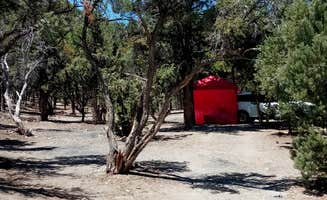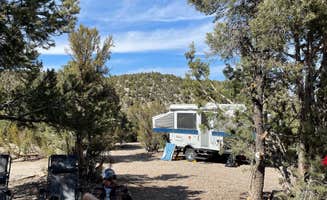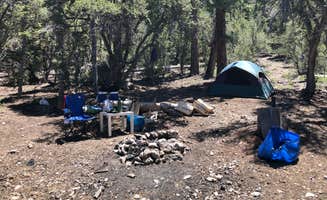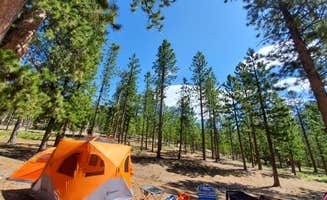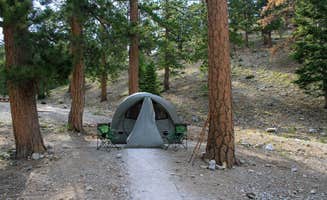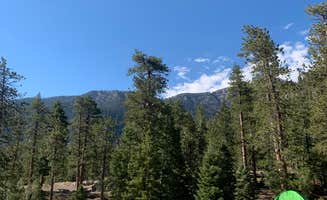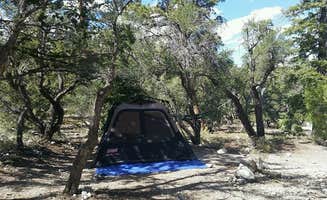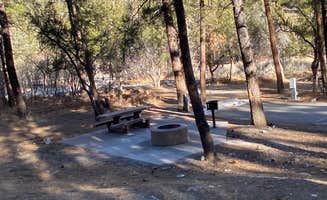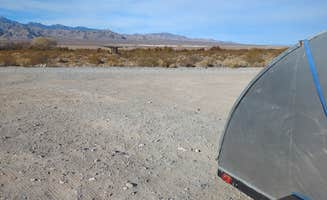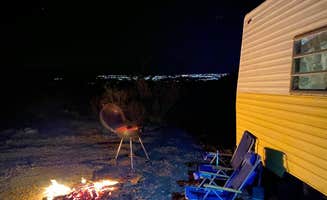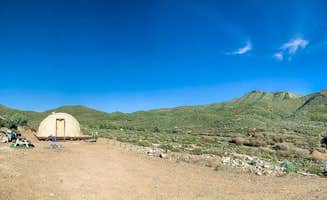Camping spots near Indian Springs, Nevada combine desert environments with high-altitude forest areas. The region spans elevations from 3,100 feet in valley areas to over 8,500 feet at mountain campsites, creating temperature variations that can exceed 30 degrees between locations. Primitive camping areas predominate, with most sites lacking developed facilities but offering unrestricted access to hiking trails and geological features.
What to do
Mountain biking trails: Mack's Canyon Dispersed offers access to multiple trails suitable for mountain biking. A camper noted, "About a mile down the road is Sawmill trailhead. They have picnic areas and trails you can explore."
Stargazing sessions: Find prime night sky viewing at higher elevation sites. "We found a spot to setup my hammock to watch the stars at night. Very few insects due to the elevation, and except for the occasion airplane taking off from Vegas, pretty quiet," mentions a camper at Red Rock Canyon National Conservation Area.
Winter snow activities: Some sites receive significant snowfall during winter months. A visitor to Champion Road Dispersed Campsites reports, "I went in February and got some nice slow flurries which was a nice treat. Problem was that is snowed through the night and I woke up to about three inches."
Wildlife viewing: Early morning and evening hours provide opportunities to spot local wildlife. "We saw a small herd of wild mustangs go through our site! Very cool!" notes a camper who stayed at McWilliams Campground.
What campers like
Temperature relief: The high elevation camping areas provide significant cooling during summer months. A visitor to Fletcher View reported, "When I turned off the highway about 15 miles from the site it was close to 110 degrees and when we got to our site it was down to 85."
Accessibility from Las Vegas: Many campers appreciate the proximity to urban areas while feeling remote. "Just about anytime I head towards this site, you will see people tent or truck bed camping. Anything after a mile down the road has picnic areas and trails you can explore," says one review of Mack's Canyon.
Low light pollution: Higher elevation sites offer exceptional night sky viewing. A camper at Champion Road Dispersed Campsites commented, "The stargazing is great as the forest is bristlecone and the canopy does not block the view of the Milky Way."
Spring water access: Some camping areas feature natural springs. A visitor to Mack's Canyon noted, "There are two little springs that seep out of the ground. I just love how quiet it is you get about a handful of people that come up to see the flowers that are near the spring."
What you should know
Fire restrictions change frequently: Most areas have seasonal fire bans. "We filled a trash bag of trash, it was super windy so I'm assuming people's trash just was flying everywhere. No fires ONLY propane, don't be a jerk and try to get by just follow the rules so everyone can enjoy nature," advises a camper at Champion Road Dispersed Campsites.
Cell service is limited: Coverage varies significantly by location and elevation. "I have T-Mobile and was pleasantly surprised to have a bar or 2 of 4G LTE service. Most of Lee Canyon does not have any service," reports a visitor to Blue Tree Group Camp.
Seasonal crowding: Popular sites fill quickly, especially on weekends. "Just went here for my first time and I love it. I think next time I'll definitely reserve a spot I want because it was a little packed," writes a McWilliams Campground visitor.
Weather changes rapidly: Temperature swings can be extreme, especially at higher elevations. A camper at Hilltop Campground mentioned, "High altitude, does get quite chilly at night. Bring your own water or fill up at lee canyon campsite (20 minutes down the road) for free."
Tips for camping with families
Pack for temperature swings: Prepare for significant day-to-night temperature changes. "In the summer the night temperatures are in the low 60s so no need for air conditioning. We love camping at Mount Charleston in the summer! It provides the perfect break from the Vegas heat!" writes a camper about Hilltop.
Establish sites early: Most family-friendly sites fill quickly on weekends. "Pretty busy, and people were a bit noisy but enough space between areas that couldn't see anyone else, felt secluded and was nice and cool!" reports a Champion Road visitor who arrived at 6pm on a Saturday.
Wildlife awareness: Several camping areas have regular wildlife visitors. "We saw multiple birds in the campground as well, including a Western Tanager! I haven't seen any wildlife up there except for chipmunks, but the trees are great," notes a camper.
Seek developed sites for amenities: Families often prefer campgrounds with restrooms and designated areas. "Sites have ample space, fire pits and good distance from neighbors. Many trees make it so you have a shady spot to camp. Running water and a helpful host," reports a McWilliams visitor.
Tips from RVers
Road condition considerations: Many dispersed areas have rough access roads. A visitor to BLM Dispersed Camping near Indian Springs advised, "A little tough to set up camp with the desert landscape but perfect off the main road stop away from busy cities to get some rest."
Size limitations: Most dispersed sites accommodate smaller RVs only. "Anything bigger than a truck might be a problem. Found a good spot here to bring the RV. There were a few fire rings already built. Great views and easy to access," mentions a Champion Road camper.
Camp host insights: Developed campgrounds often have hosts who enforce rules. "Camp hosts are nice. Pretty secluded dry camping. Almost always can find a spot. The sites are all pretty big and have lots of level areas," notes a camper about Blue Tree Group Camp.
Setup challenges: The terrain can present challenges for larger vehicles. A visitor advised, "The dirt road takes you far out of the way and away from everything. Some of the sites are situated on the side of mountains so the views (especially at sunset) are breathtaking. Sites are spacious and set far away from each other."


